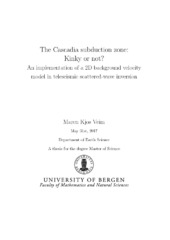The Cascadia subduction zone: Kinky or not? An implementation of a 2D background velocity model in teleseismic scattered-wave inversion.
Master thesis
Permanent lenke
https://hdl.handle.net/1956/16422Utgivelsesdato
2017-06-23Metadata
Vis full innførselSamlinger
- Department of Earth Science [1050]
Sammendrag
This thesis, within the field of seismology, investigates the process and effect of implementing a complex reference model in a teleseismic migration technique based on the Inverse Generalized Radon Transform. This migration technique utilizes concepts from the field of integral geometry, in order to accurately generate high resolution images of the subsurface. This technique is particularly powerful in the case of subduction zones, as indicated by previous applications, such as that of Rondenay et al. (2001). A subduction zone is a geological setting in which one tectonic plate plunges underneath another. As the plate plunges downwards, it releases water due to an increase in pressure and temperature. This water enters the mantle of the overriding plate and changes the petrology of this area, the forearc mantle, through hydrothermal reactions. Understanding this process is important, as it might lead to an increased understanding of mantle dynamics in general, and the dynamics of subduction zones in particular. A key step to an increased understanding is to accurately map the spatial extent and material properties of the plunging plate and the forearc mantle. To better image these features, this thesis describes the implementation of an improved imaging method that addresses a limitation in the original teleseismic migration approach of Rondenay et al. (2001). The original technique utilizes a 1D background velocity model as a basis for key calculations. Assuming that the seismic properties of a subduction zone is restricted to a 1D geometry is a major simplification. In this thesis I address this simplification by modifying the method to account for a 2D background velocity model. By addressing this limitation I am able to generate images of higher robustness and resolution. I demonstrate the effect of this implementation by applying the new modified method to both synthetic data and real data obtained from the Cascadia subduction zone. Through this application I observe that the imaging of the dip of the subducting plate is better resolved by the implementation of a 2D background model, and that the features of the subduction zone are, in general, better constrained using the new improved method. I therefore conclude that, while more research and development can and should be done in this area, the implementation of a 2D background velocity model described in this thesis is a promising step towards a better resolved subduction zone system.
